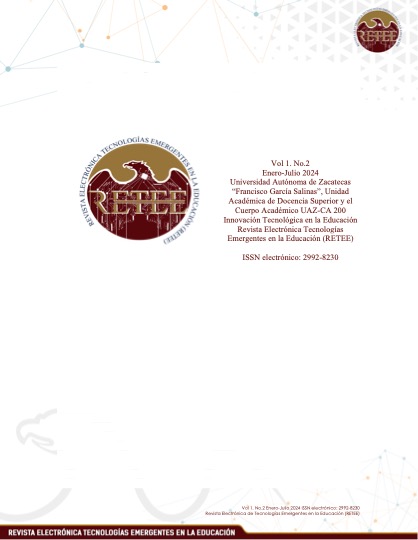Using the Flippity app for group integration of normal school students
Published 2025-01-08 — Updated on 2025-01-09
Keywords
- Flippity,
- Group integration,
- Normalistas
Copyright (c) 2025 Juan Manuel Nuño Martínez

This work is licensed under a Creative Commons Attribution 4.0 International License.
How to Cite
Abstract
Within the school dynamics, the lack of group integration, the collaboration between teachers and the development of the work are areas of constant opportunity, therefore, the objective of the research has been to show how through the Flippity application it was possible to integrate a group of teacher training students. The methodology used was mixed, as a data collection instrument a questionnaire was used through Google, which was applied to the subjects of the study, 16 teacher training students of the VI semester of the Teacher Training Center, Zacatecas. The quantitative results show that 68.8% of the subjects of the study did not know the Flippity application, likewise 100% considered that working with it allowed them to get closer to classmates who are outside their circle of friends, likewise, 100% believe that using this application was positive, the same percentage considers using Flippity in their classes with high school teenagers to promote integration. The qualitative results show that the students found the experience of working with Flippity to be positive, as well as a quick and fun way to integrate the group, while interacting with other members of the class, which improves coexistence and socialization. In conclusion, it was shown that the design and application of this educational intervention proposal brought positive results in the integration of the students, and that in subsequent classes it was not necessary to use the application to integrate the work teams in an equitable, fair and inclusive manner.
Downloads
References
- Arias, F. (2012). El proyecto de investigación. Introducción a la metodología científica. Caracas. Editorial Episteme.
- Balestrini, F. (1998). Cómo se elabora el proyecto de investigación. Caracas. Editores Consultores.
- Bernal, J. (s/f). Integración grupal. Universidad Autónoma de Aguascalientes. DGSE.
- Cámara de Diputados del H. Congreso de la Unión, (2021) Constitución Política de los Estados Unidos Mexicanos. https://www.diputados.gob.mx/LeyesBiblio/pdf/CPEUM.pdf
- Centro de Actualización del Magisterio, Zacatecas (2020) Plan de Desarrollo Institucional. https://camzac.edu.mx/index.html
- Coordinación General Jurídica, (2018) Ley de educación del Estado de Zacatecas. http://cgj.zacatecas.gob.mx/MJE/LEYES/Ley%20de%20Educaci%C3%B3n%20del%20Estado%20de%20Zacatecas.pdf
- Hernández Sampieri R., Fernández Collado C. y Baptista P. (2014), Metodología de la investigación, editorial Mc Graw Hill, México.
- Lucero, M, (2003). Entre el trabajo colaborativo y el aprendizaje colaborativo. Revista Iberoamericana de Educación, 33 (1), 1-20. https://rieoei.org/RIE/article/view/2923/3847
- Maliza, Manobanda, G. (2019). La gamificación y su relación en el aprendizaje. [Tesis de Licenciado en Ciencias de la Educación, Universidad Técnica de Ambato] https://repositorio.uta.edu.ec/server/api/core/bitstreams/7fbc6826-0402-405a-9865-d602d8ced95b/content
- Ministerio de Educación, del Gobierno de Chile (2021). Recursos Educativos y Documentos Curriculares. https://www.curriculumnacional.cl/portal/Innovacion/Lineas-de-Innovacion/Texto-Digital-Interactivo/224038:Guia-rapida-N-20-Como-usar-Flippity-y-el-TDI
- Nuño, J. (2018). Geografía en secundaria. Dos propuestas para lograr el aprendizaje significativo. Revista Correo del Maestro, 23 (269), 42-46. https://independent.academia.edu/JuanManuelNu%C3%B1oMart%C3%ADnez
- Organización de las Naciones Unidas para la Educación, la Ciencia y la Cultura. (2015). Declaración de Incheon y Marco de Acción para la realización del Objetivo de Desarrollo Sostenible 4 – Educación 2030. UNESCO.
- Organización de las Naciones Unidas para la Educación, la Ciencia y la Cultura, (2022) Las TIC en la educación. https://es.unesco.org/themes/ticeducacion#:~:text=La%20UNESCO%20comparte%20los%20conocimientos,la%20integraci%C3%B3n%20y%20perfeccionar%20la
- Pereira Pérez, Z. (2011). Los diseños de método mixto en la investigación en educación: Una experiencia concreta. Revista Electrónica Educare, XV (1),15-29. [fecha de Consulta 22 de septiembre de 2022]. ISSN. Disponible en: https://www.redalyc.org/articulo.oa?id=194118804003
- Pole, K. (2009) Diseño de metodologías mixtas. Una revisión de las estrategias para combinar metodologías cuantitativas y cualitativas. Renglones, revista arbitrada en ciencias sociales y humanidades, 60, 37-42. https://rei.iteso.mx/server/api/core/bitstreams/ee397b99-bb24-4c3e-ba94-b9dde4563026/content
- Programa Sectorial de Educación 2020-2024, (2020). Programa Sectorial derivado del Plan Nacional de Desarrollo 2019-2023. https://www.gob.mx/cms/uploads/attachment/file/562380/Programa_Sectorial_de_Educaci_n_2020-2024.pdfm
- Secretaría de Educación Pública, (2017) Plan y programas de estudio, orientaciones didácticas y sugerencias de evaluación. Aprendizajes clave. México, SEP.
- Secretaría de Educación Pública (2018). Licenciatura en Enseñanza y Aprendizaje de la Geografía en Educación Secundaria. SEP. https://www.cevie-dgesum.com/index.php/planes-de-estudios-2018
- Secretaria de Educación Pública (2019). La Nueva Escuela Mexicana: principios y orientaciones pedagógicas. SEP. https://dfa.edomex.gob.mx/sites/dfa.edomex.gob.mx/files/files/NEM%20principios%20y%20orientacio%C3%ADn%20pedago%C3%ADgica.pdf


